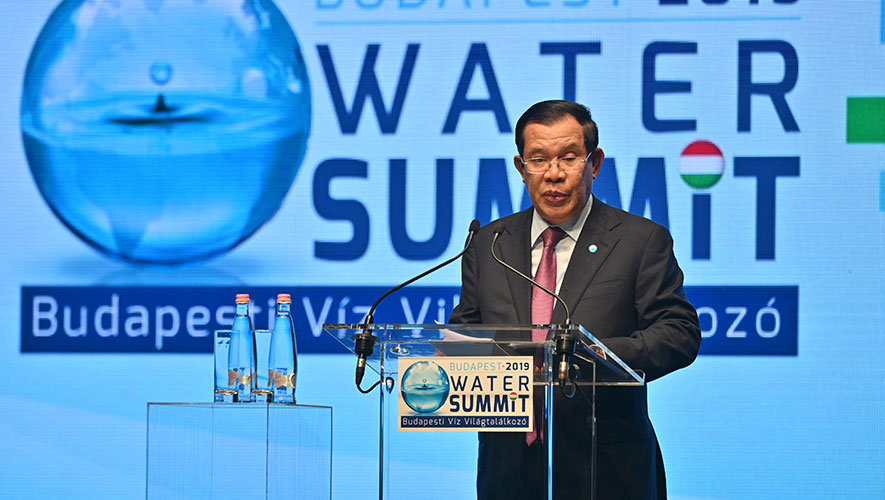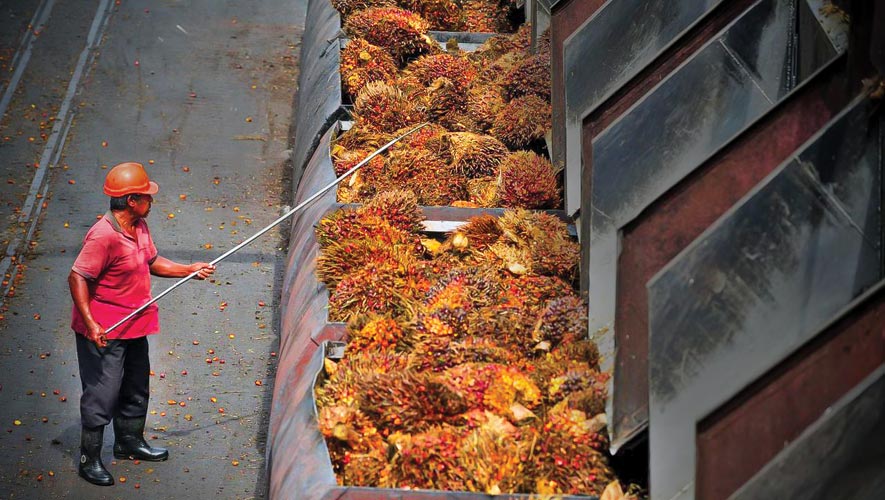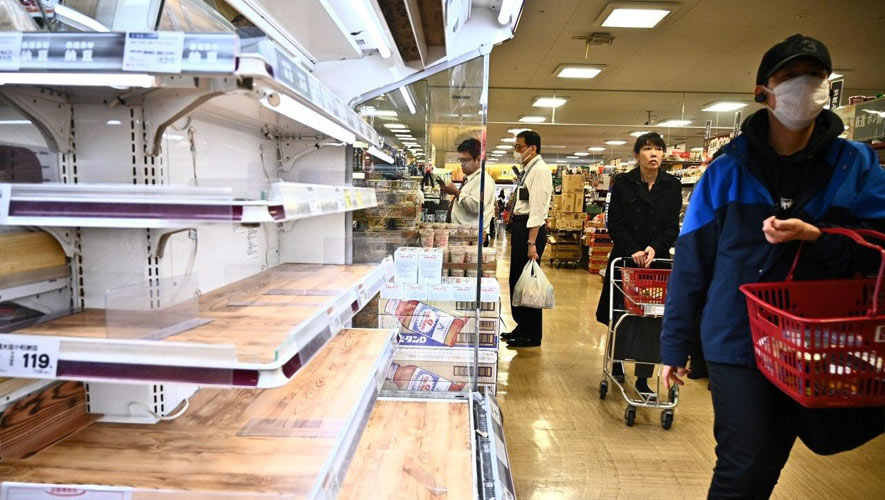Every day at 5am in the morning, residents living in the outskirts of the capital of Phnom Penh are carrying a couple of 30-litre gallons to get water from several 10,000-litre water tanks deployed along the road.
For the latest Cambodian Business news, visit Khmer Times Business
Some districts situated in the west of Phnom Penh City, about 20 kilometres – namely Kamboul, and Posenchey – are facing a clean water shortage that demands urgent resolution.
Starting from February each year since 2018, there is very low water pressure or no clean water in the pipe of the Phnom Penh Water Supply Authority (PPWSA), said a resident, living in Borey New World Kamboul, Kamboul district, who wished to remain anonymous.
“Although we installed a small pumping motor to pump the water from the PPWSA’s pipe, there is no water. Sometimes, we wake up at midnight waiting to pump water,” he added. “It is difficult to live without water because we need it for drinking, bathing, cooking and laundry.”
Another resident, Hay Saren, 38 living in the same borey, said that every morning at around 5am, she and her neighbours wake up and carry a couple 30-litre containers to get water from big water tanks which are deployed along the park in the borey campus.
Hay said that she does this every day – twice per day, in the morning and evening. “Luckily, the borey’s owner setup several 10,000-litre tanks and drew water from underground, so we have water for our daily consumption otherwise, we woud not know where to get it.
“A water shortage happens almost every year when it comes to the dry season, especially from February to April. We have encountered this situation for two consecutive years already. Now we are still facing the issue.”

It’s not only Kamboul and Posenchey districts which face the water shortages, but residents in some areas of Phnom Penh, surrounding areas and Ta Khmau town face another three years of a shortage of clean water access as demand grows while production capacity is limited, said Sim Sitha, director-general of Phnom Penh Water Supply Authority (PPWSA), the municipal water utility that serves Cambodia’s capital Phnom Penh and surrounding areas.
“The trend of water shortage in some districts of Phnom Penh and Kandal province has occurred from 2018 to 2021,” he added.
Sim said that this year, the production capacity is about 600,000 cubic metres per day, while the actual demand is around 700,000 cubic metres a day. In 2021, the production capacity will remain at about 600,000 cubic metres per day but the demand will keep increasing year-on-year. The number of actual clients has increased from 390,067 in 2019, up to 410,067 this year and is estimated to be 430,067 in 2021, 450,067 in 2022 and 470,067 in 2023.
At present there are four main water treatment plants, including Phum Prek Water Treatment Plant (PPWTP), which has a capacity of 150,000 cubic metres per day (m3/d). Chroy Changvar Water Treatment Plant manages 130,000 m3/d, Chamkarmon water plant provides 52,000 m3/d, and Niroth Water Treatment Plant produces 260,000 m3/d – a total of 592,000 m3/d.
Sim added that although the water authority is expanding water treatment plants year-on-year, it’s still not responding adequately to actual demand. In addition to that, the water level this year is low compared with other quarters. Therefore, untreated water pumped into the treatment plants is not equal to demand.
He said that the water level in the river has dropped from 2.79 metres in first quarter 2018, to 2.59 metres in first quarter of 2019, and 1.62 metres in first quarter of 2020. The water treatment plant could produce 549,734 m3/d in Q1 2018, 581,629 in Q1 2019, and 620,455 in Q1 2020.
However, moves are being made to address the problem. PPWSA is building new Bak Kheng water treatment plants I and II in the northern outskirts of the Cambodian capital. Bak Kheng Water Treatment Plant I will be capable of producing 195,000 cubic metres and Bakheng II is able to produce 195,000 cubic metres of water. Therefore, in 2022, Phnom Penh will be able to supply 807,000 cubic metres per day and 1 million cubic metres per day in 2023.
“We lack around 100,000 cubic metres per day of water. It is equal to the demand of one factory. It is not the first time. We have experienced this since 2019,” Sim explained.
Sim added that water production capacity has increased year-on-year. “In 2016, we produced about 400,000 cubic metres per day, but now we produce around 600,000 cubic metres per day. The demand is high and the water treatment plants are limited. Thus, we cannot produce more than one factory’s capacity.
“We will build a new factory. It takes time. In the intervening period there will still be a water-shortfall. The solution is that we get together with Phnom Penh’s City Hall governor to request that all district governors set up water tanks and distribute water to citizens,” Sim added.
“Meanwhile, we are running a campaign about sharing water with each other. call on our customers, especially people who are living near the water treatment plant, to save water and not use too much for daily consumption. This will allow the water to reach the outskirts. Now there is a campaign for sharing water with each other.”
Khim Sunsoda, Kamboul’s governor, says that almost every commune in his districts is facing a water shortage. Three communes are affected the most – Kantauk, Kambol and Phloeung Chheh Roteh.
However, he says that he has assigned officials to carry water to distribute to the people who do not have any. So far, the district has installed 10,000-litre water tanks in 10 different areas, with a concentration in the most-affected commune trio.
“We can see that almost all the communes in Kambol district are affected by a water shortage because the water pressure in the PPWSA’s pipe is too low. In some areas, people use ponds,” Khim added.
“People can use the water we provide for cooking and drinking and for bathing and laundry. They can use the water from wells or ponds,” he said. “We carry the water daily. We have two big trucks and do trips twice per day,” Khim said.

Oum Sotha, spokesman for the Ministry of Industry and Handicraft, said the ministry acknowledged the lack of clean water on the outskirts of Phnom Penh city.
However, he said that the shortage of water does not mean the government is not expanding the ability to produce clean water and the government has expanded from just 300,000 cubic metres per day up to 600,000 cubic metres per day. However, this cannot meet the need which has surged dramatically for the last two to three years.
Oum added that construction, infrastructure, boreys, other residential projects and the number of migrant workers from various provinces have grown remarkably over the last five years. This is the cause of the high demand in water consumption.
“The big project we hope will solve the water shortage in Phnom Penh City for the long term is the construction of the water treatment plants of Bak Kheng I, II. The plants will able to produce around 400,000 cubic metres per day,” he added.
“What I want to emphasise is that currently we are concerned about the projects because they are related to the consultant, contractors, and experts from various countries and we have the issue of COVID-19,” Oum said.
He added that the Covid-19 has led the effect on the project. Though they set the schedule to build the plant, but some cannot make it as now some countries is banned and flight cancel so the travel is strict, so the work is also not smooth. This is the main challenge for us because now we are considering with our partners how to proceed with our plan.
“We acknowledge the shortage and understand the situation. Therefore, we have expanded more, but the investment cannot be realised immediately. We need time and a step-by-step approach. We also have a limited budget,” he added.
“Please, we want all the people living in the city to understand the water shortage during the dry season. The ability to supply enough water has not yet been accomplished. Because the country developed fast, it faces water shortages,” he said.
“Moreover, consumers who use more water should help by reducing the amount they use on flowers, trees, car washes etc.”




